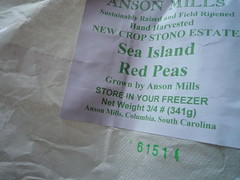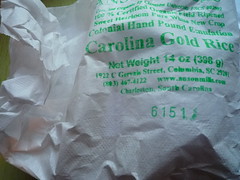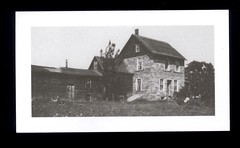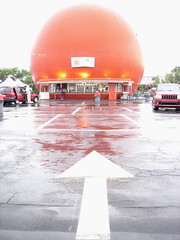Hudson River School, rev. ed.
 fig. a: self-portrait w/ xmas ornaments
fig. a: self-portrait w/ xmas ornaments
The holidays found us back in the Catskills, taking pictures of ourselves reflected in Christmas ornaments,
 fig. b: barn, Cornwallville, NY
fig. b: barn, Cornwallville, NY
exploring big, old barns,
 fig. c: view of the Hudson River Valley
fig. c: view of the Hudson River Valley
and studying the landscape. This view is from Olana,
 fig. d: Olana
fig. d: Olana
the outlandish Orientalist fantasy home built by the Hudson River School's Frederic Edwin Church on a site that affords spectacular views of the Hudson River, the Catskills, and the Taconic hills, a site Church called "the center of the world."
 fig. e: gnarly!
fig. e: gnarly!
Church fetish for all things Persian may have been somewhat incongruous, but Michelle approved of Olana's views and its sense of whimsy (including its heart-shaped pond), and she was especially fond of Church's taste in outdoor furnishings.
Hudson
 fig. f: Hudson Gothic
fig. f: Hudson Gothic
The town of Hudson is a handsome Hudson River Valley town with a handsome Amtrak station that also happens to be one of the town's most important landmarks. Not only is Hudson's train station a stately, subdued example of American Gothic, not only is it the oldest continuously operational train station in the entire state of New York, but it happens to be across the street from one of New York's very best cafés.
 fig. g: inside Strongtree
fig. g: inside Strongtree
That's right, directly across the street you'll find the good people at Strongtree Organic Coffee Roasters, purveyors of the "finest quality organic heirloom coffees." In many ways, 2009 was the Year of Coffee for us, the year that we had 4 or 5 of the most momentous coffee experiences of our entire lives. Strongtree was the final coffee discovery of the year (TY, S & T!), but it vaulted right into our Top 3. We loved this place from the moment we set foot in the joint. The fact that they were playing the dubbed -out sounds of This is Reggae Music, vol. 3, an album that, by all reasonable measures (longest history, most listens, etc.), is my #1 reggae album of all time, certainly didn't hurt.
 fig. h: Santa's little helpers
fig. h: Santa's little helpers
The display of loopy holiday art didn't hurt either. But what really caught our attention was that first cappuccino. This was not your average espresso shot. It left a tremendously memorable impression. So memorable, in fact, that two days later we remembered to make a special detour back to Strongtree to pick up some beans and have an even more impressive espresso shot. This time time made with their Conquering Lion blend (irie!), this time served up as a latte. But what sealed the deal was when we got back home and brewed up our first batch of their Ethiopian Lekempti Viennese Roast. "Strong dark fruit and deep chocolate flavor," indeed. Again, easily one of our Top 3 coffees of the year.
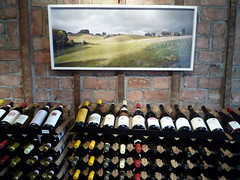 fig. i: inside Hudson Wine Merchants
fig. i: inside Hudson Wine Merchants
Hudson is also blessed with an awfully impressive wine shop: Hudson Wine Merchants. Not only do the folks at HWM share our passion for landscape, but they stock a great selection of Italian wines, including an awfully tasty Campo di Sasso Insoglio del Cinghiale 2006.
 fig. j: Hudson diner
fig. j: Hudson diner
And, if you're interested, Hudson also has a beautifully streamlined vintage diner, which is currently FOR SALE. Takers?
Kingston
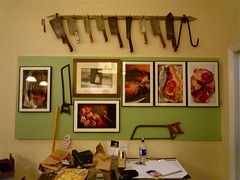 fig. k: inside Fleisher's
fig. k: inside Fleisher's
If Strongtree was one of the highlights of our trip, the other major highlight was found not in Hudson, but about an hour south along the NY Thruway in Kingston. Fleisher's Grass-Fed & Organic Meats is a new school butcher shop run by Joshua & Jessica Applestone that has very deservedly received an enormous amount of attention in the five years since they opened. Fleisher's is the epitome of principled: not only is all their meat organic, but it's all grass-fed, pasture-fed, and ethically raised. In fact, Joshua & Jessica established a set of tenets when they opened up shop, principles that guide the way they run their operation and the way they do business. They look something like this:
-All farms are multigenerational with a long history of ethical practices.
-Farmers are proponents of proper animal husbandry for all animal reproduction.
-Animals always have access to grass and open pastures and are not kept in pens.
-Animals are rotated through pastures to ensure they have exercise and fresh grass to eat.
-Animals are not given antibiotics or hormones.
-Animals live in closed herds.
-All feed and grains must come from local mills and farms. Store bought grain is never acceptable.
-Animals travel less than an hour to the slaughterhouse.
Where does this commitment to sourcing and carving the very best, most humanely raised meat come from? Well, interestingly, it comes from a shared history of vegetarianism. Joshua & Jessica were both vegetarians when they first met. Hell, Joshua was a vegan. For 17 years (!). Obviously, they left their vegetarian ways behind years ago, but their food ethics remained, and they've made a business out of supporting and promoting a humane and human-scale approach to animal husbandry.
The Fleisher's story is a nice story, too. Not only is it founded on a love story, but there's some real history to it. You might think that the Fleisher's name is just a clever play on the word "butcher," but you'd be wrong. The store is named after Wolf Fleisher, a kosher butcher who came to America in 1901 and set up his own shop--the original Fleisher's--in Brooklyn. The business became a success, known for the high quality of its beef and poultry, as well as the high standards by which it was run. Joshua is Wolf Fleisher's great-grandson, and the Fleisher's tradition lives on.
Now, we'd read about Fleisher's a while back, but it all seemed so faraway and exotic (perhaps because no butcher shop in Montreal is even remotely as progressive) until we happened to meet Joshua & Jessica at Joe Beef on a balmy summer night back in August (TY, AG, TY, JB!). We got to talking and when they graciously invited us to come down and pay them a visit, we pledged to do just that at the soonest opportunity.
It's one thing to hear or read about an all-organic, grass- and pasture-fed meat shop, but it's a whole other thing to see one in operation, especially when it takes the shape of a good, old-fashioned neighborhood butcher shop (albeit one that does a healthy trade with several of New York's finest restaurants, 90 miles down the Hudson), especially when the run-up to Christmas is very much on. This joint was jumping. Fleisher's had a full team in full swing, carving up sides of beef, putting together special orders, tending to customers. Somehow Joshua & Jessica still found the time to give us a tour and chat with us.
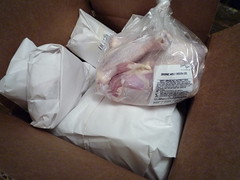 fig. l: the haul
fig. l: the haulWhen we got back home, we had a box full of Fleisher's organics meats purchases in tow:
6 organic whole chicken legs
2 huge, organic beef short ribs
1 organic bone-in pork shoulder
1 massive, organic, dry-aged rib steak
4 lamb loin chops
As soon as we made our first Fleisher's meal we started to have regrets about not buying more. Four meals later and still batting 1.000 (actually, these meals have been so good, it feels like we're batting over 1.000), we're kicking ourselves (hard!).
Here are the first two:
AEB Chicken & Dumplings
1 tbsp olive oil
1 small organic chicken, cut into parts, or 6 organic whole chicken legs
1 medium onion, finely chopped
2 ribs of celery, finely chopped
2 medium carrots, finely chopped
1/4 cup parsley, minced
4 tbsp flour
1 cup dry white wine
2 cups chicken or vegetable stock
salt & freshly ground pepper
dumplings:
2 cups sifted all-purpose flour
1/4 tsp salt
2 rounded tsp baking powder
1 tsp brown sugar
2 tbsp butter
2/3 cup buttermilk
Heat the oil in a large stove- and ovenproof casserole over medium heat. Salt and pepper your chicken liberally. When the oil begins to smoke, brown your chicken parts or legs, roughly 5 minutes per side. You might need to do this in batches. I did. When the chicken parts have been browned, remove them from the casserole and set them aside. Add the onion to the casserole and sauté until the onion has turned translucent. Add the celery and the carrots and continue sautéing, 2 to 3 minutes. Add the parsley, sauté another minute, then add the flour and sauté for another 1-2 minutes, stirring constantly, until the vegetable have turned a pale golden hue. Add the white wine and the chicken/vegetable stock. Add the browned chicken pieces. Bring to a boil, then turn the heat way down and simmer ever so gently for 45 minutes.
Meanwhile, prepare the dumplings. Sift the flour, salt, baking powder, and sugar into a mixing bowl. Add the butter, blending with your fingertips. Add the buttermilk and mix well. Spoon the dough onto a floured surface and roll it evenly 1/4 inch in diameter. Cut into 1-inch rounds or diamond shapes.
When the chicken has cooked for 45 minutes, taste and adjust the seasonings. Add the dumplings. Cover and cook for another 20 minutes at a gentle simmer. Test the dumplings--they should be light, airy, and fully cooked through. Serve the chicken and dumplings in wide, shallow bowls. Devour.
[the dumplings part of this recipe is based on Edna Lewis' recipe in The Taste of Country Cooking, although her recipe uses 2/3 cup of milk instead of buttermilk]
Chicken & Dumplings is one of my absolute favorite meals, but it was even better with Fleisher's plump, organic, pastured chicken. The rich gravy--always a thing of beauty--was noticeably richer, noticeably more beautiful. The chicken meat was so thoroughly delicious that we found ourselves literally gnawing at the bones, ravenously, trying to make sure we got each and every last morsel.
Equally phenomenal was this lamb chops dish that combined the Fleisher's method for cooking and savoring their grass-fed and pastured meats with elements of a Mario Batali recipe for scottaditi (one that called for the use of New Zealand lamb [!], not Hudson River Valley lamb*). Now, our lamb chops were loin chops, not the neck-end lamb chops (or frenched lamb chops) that one usually uses for scottaditi, but they were equally finger-scorching-good. Fleisher's method was very familiar to us--it's basically the exact same method we use for making our steaks--but Jessica insisted that this was a fool-proof method for preparing virtually all of their meats.*
Lamb Chops with Confited Garlic and Mint
4 lamb loin chops
1/4 cup extra-virgin olive oil
10-12 whole cloves of garlic
1 cup dry wine
1/2 cup sweet wine
salt and freshly ground black pepper
4 sprigs mint, leaves only
Heat the oil in a 10-inch sauté pan over medium heat. Add the garlic cloves and sauté slowly, shaking the pan frequently to keep the garlic moving, until they are lightly browned on all sides, about 10 minutes. Add the wines, bring to a slow boil, and cook until the liquid is reduced to 1/4 cup, at which point the garlic should be very soft, indeed. Remove from the heat and set aside.
Preheat your oven to 300º F.
Season the lamb chops liberally with salt and pepper.
Heat a stovetop-to-oven-ready pan (like a cast-iron) over medium-high heat until it reaches the smoking point. Add the lamb chops and sear for 2 minutes on each side. Remove the pan from the stovetop and place it in the oven. Cook for an additional 4-8 minutes, until your lamb chops reach your desired level of doneness (our lamb loin chops took about 6 minutes in the oven). Take the pan out of the oven. Remove the lamb chops, place them on a cutting board, and allow them to rest 5 minutes.
While the lamb is resting, season the garlic mixture with salt and pepper and add the mint leaves. Serve each lamb chop with a few confited garlic cloves and drizzle the sauce overtop.
[confited garlic and mint sauce based on a recipe in Mario Batali's Molto Italiano]
Getting schooled rarely tasted so great.
New Year's Resolution: Go back to Hudson & Kingston at the earliest opportunity.
Strongtree Organic Coffee Roasters, 60 South Front Street ("at the train depot"), Hudson, NY, (518) 828-8778
Fleisher's Grass-Fed and Organic Meats, 307 Wall Street, Kingston, NY, (845) 338-6666
aj
* That was a few years ago, I'd be surprised if Mario hasn't changed his tune by now. For one thing, Fleisher's meats are featured at Batali's Casa Mono & Bar Jamón.
** Fleisher's "cooking instructions from the MooRu***" read as follows:
1. Oven preheat 300º [10 minutes]
2. Heat pan on stovetop to smoking point
3. Pre-salt each side [5-10 minutes ahead of time]
4. Put into pan / sear for 2 minutes each side
5. Put pork/lamb/chicken/beef into oven w/ pan
6. Pork > 6 minutes up to 10 minutes in oven [125º]
Lamb > 4-8 minutes in oven [120º]
Chicken > 10-15 minutes in oven [135-140º]
Beef > 4-8 minutes in oven [120º]
7. Take out of oven--let sit [rest] for 5 minutes
*** MooRu = meat + guru
